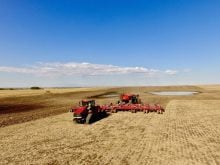Some Manitoba corn growers could be feeling a little more anxious than usual in the weeks ahead as they prepare for harvest.
Many southern portions of the province received above-average rainfall amounts this spring, which has turned out to be a mixed blessing for corn producers in the region.
While those rains helped promote early germination and plant growth in fields, the abundance of wet stuff meant the roots of those corn plants didn’t grow as deep as they normally would, since they could access moisture and nutrients close to the soil surface.
Read Also

Claas brings 1000 Series SP forage harvesters to Canada
In mid-August, Claas unveiled its new line of Jaguar forage harvesters at an event in Visalia, California, deep in the heart of that state’s dairy region.
As a result, nutrients near the surface became depleted and corn plant roots weren’t developed enough to drill further down into the soil to access additional sources.
The concern heading into this year’s harvest is those nutrient-deprived corn plants could show quality or yield losses.
“The first rains were obviously a huge blessing because we were planting into really dry conditions,” says Morgan Cott, agronomy extension specialist for special crops with the Manitoba Crop Alliance.
“It’s just that the rain kept coming and a lot of areas were getting waterlogged. Some areas were getting stunted because of the water sitting in the fields. Like anything, if corn is sitting in water for too long, it can’t breathe. There’s no oxygen so it’s just sitting there not doing anything. Some plants will die while others won’t but they never sort of rejuvenate.”

Manitoba Agriculture’s growing season report shows just how wet some corn-growing areas of the province were early on this season. Portage la Prairie received 177 mm of rain between April 15 and June 2, which is 193 per cent of the average rainfall it receives during that period of time. Meanwhile, Brandon received 162 mm (213 per cent) while Morden received 189 mm (190 per cent) and Rivers had 167 mm (211 per cent).
All that moisture meant corn plant roots tended to develop more laterally than vertically. The lack of root material meant those plants had difficulty accessing much-needed nutrients as they leached downwards into the soil over the course of the season.
“Roots are lazy. Roots will go where they have access to everything they need. Why would they be digging down deep if all the water and all the fertilizer was sitting there with them in those first couple of months,” Cott says.
Table: Prairie grain corn acres planted
| 2022 | 2023 | 2024 (est.) | |
| Alberta | 14,100 | 37,600 | 35,000 |
| Saskatchewan | * | 28,600 | 32,400 |
| Manitoba | 378,600 | 553,900 | 504,600 |
Source: Statistics Canada. * – figure deemed “too unreliable”
‘Rebound’
It’s a situation that concerns Jill Verwey and her husband Ray. They operate an 8,000-acre grain and oilseed farm just south of Portage la Prairie. They planted about 400 acres of corn this spring and ended up having to reseed about 130 acres to canola as a result of the damp conditions.
Now, their fingers are crossed that their remaining corn acres will rebound enough to produce a decent yield.
“We did get some good rebound once we had some heat. But we’re still a ways away from knowing what the effects of this year will be on the corn crop,” she says.

“That early cool, wet weather will probably have an impact at the end of day on yield. We’ll probably not see as good a yield as what we would have expected, had we had a better start in the spring. How much that loss is going to be, we won’t know until the crop’s in the bin. It’s hard to make that call at this time of year. It will definitely be more favourable… if we have some good growing conditions over the next little while.”
Cott agrees it’s too early to know how much nutrient loss occurred this season and what impact it could have on yield.
One way growers can tell if their corn plants are suffering from nutrient loss, she says, is to check the leaves near the bottom of the plant. If they have already started to fire off, or drop, it’s a likely indicator of nitrogen deficiency. Browning or yellowing lower leaves is another likely sign of nutrient deficiency.
The bad news is that if that’s the case, there’s not much growers can do about it at this point. Even if they were to apply a top dressing, it’s likely too late in the season for the plant to take it up. Normally, top dressing has to be applied to corn at the V4 stage when there are four leaves and leaf collars are visible. Foliar sprays aren’t a solution either since they can cause damage to the crop, Cott adds.
Cott says it’s really up to individual producers to determine whether to put all of their fertilizer down up front or to split it up with a top dressing midway through the season. The challenge with a split application is that producers never know when it’s going to rain or when the rain will stop, so that later application could end up having a negligible effect.
Cott’s advice to corn growers is to scout crops early and often so they can detect in a timely fashion if any nutrient deficiency is occurring and are prepared to act quickly.
“If the weather is either too dry or too wet where we are in extremes either way, then keeping your eyes on the field is the best way to know what might be the best thing to do for fertility,” she says. “It’s just important to be scouting everything as much as you can so you know what’s going on. It takes a lot of time but it’s valuable to do so.”
Depending on how the current situation plays out, this year could be something of an anomaly for corn production in Manitoba. Over the last dozen years, the number of corn acres in the province has grown from about 300,000, in 2012, to more than 500,000 in 2024. Last year, the province produced a record 1.79 million tonnes of grain corn, which represented 11.8 per cent of Canada’s total corn production.
While those numbers could drop slightly if there are any significant yield losses in the province this year, Cott expects that upward trend to continue over the long term.
“I honestly think it’s just that it’s a relatively easy crop to grow. Guys have seen success with it. Making the investments needed to be growing corn isn’t seeming like a real hit to the farm,” she says.
“There are benefits to making an investment in a drier and planters and bins. Making those investments is a lot more appealing now that we’ve seen steady success with grain corn in Manitoba. It’s a lot more justifiable.”
















